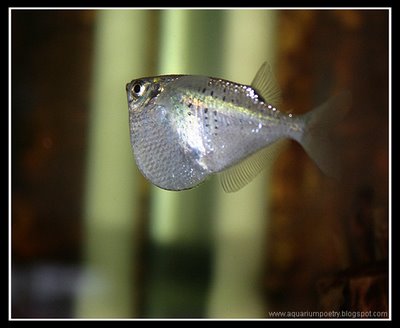Common Hatchetfish

Gasteropelecus sternicula.
Hatchet fish are a distinctively shaped fish with a deep body and wing-like pectoral fins. They are native to South America. Hatchetfish need a tank with swimming room and like a strong current. The tank must be covered as they are excellent jumpers. Most will tolerate pH around neutral and moderate hardness, but the water must be well-oxygenated. To promote breeding behaviors, more specific conditions are usually needed. They will not do well on a diet purely of dried foods, so giving plenty of frozen food is necessary.Hatchetfish are active but peaceful shoaling fish. They will not damage plants so are quite suited to planted aquariums. In community tanks, avoid mixing them with species that are too aggressive.The tank temperature should be 26°C, with pH 6,5. They grow up to 6 cm.
Photo by Dusko Bojic















